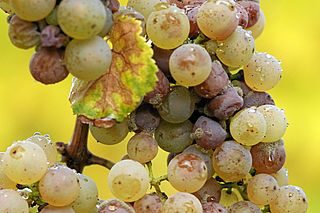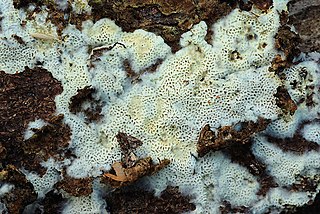
Honeysuckles are arching shrubs or twining vines in the genus Lonicera of the family Caprifoliaceae. It includes 158 species native to northern latitudes in North America, Eurasia, and North Africa. Widely known species include Lonicera periclymenum, Lonicera japonica and Lonicera sempervirens. L. japonica is a highly invasive species considered a significant pest in parts of North America, Europe, South America, Australia, and Africa.

Noble rot is the beneficial form of a grey fungus, Botrytis cinerea, affecting wine grapes. Infestation by Botrytis requires warm and humid conditions, typically around 20 degrees celcius and above 80% humidity. If the weather stays wet, the undesirable form, "bunch rot" or "grey rot", adversely affects winemaking by disrupting fermentation and changing the taste, aroma, and appearance of the final wine Grapes typically become infected with Botrytis when they are ripe. If they are then exposed to drier conditions and become partially raisined, this form of infection is known as noble rot. Grapes picked at a certain point during infestation can produce particularly fine and concentrated sweet wine. Wines produced by this method are known as botrytized wines, and are considered a distinct category of dessert wines.

Link rot is the phenomenon of hyperlinks tending over time to cease to point to their originally targeted file, web page, or server due to that resource being relocated to a new address or becoming permanently unavailable. A link that no longer points to its target, often called a broken, dead, or orphaned link, is a specific form of dangling pointer.

Dryas is a genus of perennial cushion-forming evergreen dwarf shrubs in the family Rosaceae, native to the arctic and alpine regions of Europe, Asia and North America. The genus is named after the dryads, the tree nymphs of ancient Greek mythology. The classification of Dryas within the Rosaceae has been unclear. The genus was formerly placed in the subfamily Rosoideae, but is now placed in subfamily Dryadoideae.

Rotting Christ is a Greek black metal band formed in 1987. They are noted for being one of the first black metal bands within this region, as well as a premier act within the European underground metal scene. They are also responsible for creating the signature Greek black metal sound prevalent in the early 1990s.

Dry rot is wood decay caused by one of several species of fungi that digest parts of wood which give it strength and stiffness. It was previously used to describe any decay of cured wood in ships and buildings by a fungus which resulted in a darkly colored deteriorated and cracked condition.

Rot-Weiss Essen is a German association football club based in Essen, North Rhine-Westphalia. The club plays in the 3. Liga, at the Stadion an der Hafenstraße.

Rot-Weiß Oberhausen is a German association football club in Oberhausen, North Rhine-Westphalia. The club was formed as Oberhausener SV in December 1904 out of the merger of Emschertaler SV (1902) and the football enthusiasts of Oberhausener TV 1873. The new side entered into a union with Viktoria Styrum BV to create SpVgg 1904 Oberhausen-Styrum, but within six months a number of the club's members left to form 1. FC Mülheim-Styrum. The remaining club members carried on and in 1934 took on their current name.
Disc rot is the tendency of CD, DVD, or other optical discs to become unreadable because of chemical deterioration. The causes include oxidation of the reflective layer, reactions with contaminants, ultra-violet light damage, and de-bonding of the adhesive used to adhere the layers of the disc together.

FC Rot-Weiß Erfurt is a German association football club based in Erfurt, Thuringia.
Root rot is a condition in which anoxic conditions in the soil or potting media around the roots of a plant cause them to rot. This occurs due to excessive standing water around the roots. It is found in both indoor and outdoor plants, although it is more common in indoor plants due to overwatering, heavy potting media, or containers with poor drainage. The leaves of plants experiencing root rot often yellow and die, and if allowed to continue, the condition can be fatal to the plant.
The 2004–05 2. Bundesliga was the 31st season of the 2. Bundesliga, the second tier of the German football league system. 1. FC Köln, MSV Duisburg and Eintracht Frankfurt were promoted to the Bundesliga while Eintracht Trier, Rot-Weiß Oberhausen, Rot-Weiss Essen and Rot-Weiß Erfurt were relegated to the Regionalliga.

A wood-decay or xylophagous fungus is any species of fungus that digests moist wood, causing it to rot. Some species of wood-decay fungi attack dead wood, such as brown rot, and some, such as Armillaria, are parasitic and colonize living trees. Excessive moisture above the fibre saturation point in wood is required for fungal colonization and proliferation. In nature, this process causes the breakdown of complex molecules and leads to the return of nutrients to the soil. Wood-decay fungi consume wood in various ways; for example, some attack the carbohydrates in wood, and some others decay lignin. The rate of decay of wooden materials in various climates can be estimated by empirical models.

Sambucus racemosa is a species of elderberry known by the common names red elderberry and red-berried elder.

Anomoporia is a genus of fungi in the family Amylocorticiaceae. The genus was circumscribed by Czech mycologist Zdeněk Pouzar in 1966.

Hasteola is a genus of flowering plants in the daisy family, Asteraceae.

Acleris shepherdana, the meadow-sweet button, is a species of moth of the family Tortricidae. It is found in Europe, where it has been recorded from Great Britain, France, the Benelux, Germany, Denmark, Austria, Switzerland, Italy, the Czech Republic, Slovakia, Poland, Hungary, Norway, Sweden, Finland, the Baltic region and European Russia. It is also found in the Russian Far East (Ussuri), Manchuria, Mongolia, China and Japan. The habitat consists of fens, marshes, river-banks and other damp areas.

Daphne kamtschatica is a species of shrub in the family Thymelaeaceae. It is native to parts of Korea and Japan, as well as Kamchatka.
Noccaeopsis is a monotypic genus of flowering plants in the family Brassicaceae. It is endemic to Eastern Russia.

Anomoporia bombycina is a species of fungus belonging to the family Fomitopsidaceae.















